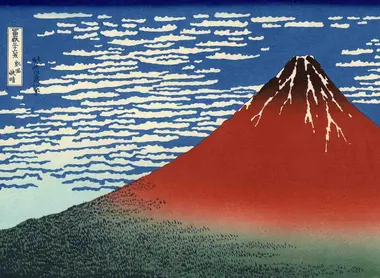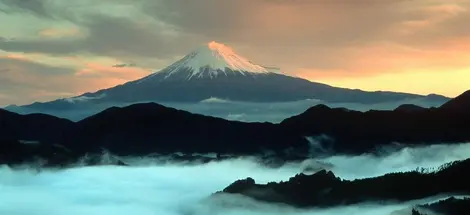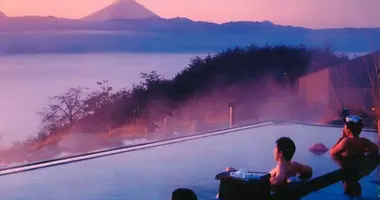Mount Fuji toll: everything you need to know about the new regulations
- Published on : 31/01/2017
- by : C.W.
- Youtube
Paying respects
Since 2024 , access to Mount Fuji has been subject to a pricing and quota system on its main trail. Faced with the 220,000 annual visitors who climb this emblematic Japanese mountain, the authorities have decided to take action to preserve this UNESCO heritage site. This initiative is aimed at combating over-visiting, littering and ensuring the safety of hikers. If you're thinking of undertaking this mythical ascent, it's essential to know about these new provisions, their costs, the free alternatives and how to prepare adequately for this unforgettable experience.
Why is access to Mount Fuji now subject to a fee?
Mount Fuji, Japan's national symbol and a UNESCO World Heritage Site since 2013, is facing serious challenges due to its growing popularity. With over 220,000 visitors during the short summer opening period (July to September), the volcano is under considerable pressure on its fragile environment.
The authorities of the Yamanashi and Shizuoka prefectures, which jointly administer the mountain, have had to deal with several major problems: the accumulation of garbage along the paths, soiled toilets, deterioration of paths and infrastructure, and inappropriate behaviour by some visitors. Governor Kotaro Nagasaki stressed that these measures are "first and foremost aimed at protecting the lives of hikers".
The phenomenon of "Bullet Climbing" also worried the authorities. This practice consists of starting an ascent during the night without adequate preparation, reaching the summit at sunrise, then immediately descending without staying in the refuges. This approach considerably increases the risk of accidents and illness due to altitude and exhaustion.
Every year, several serious incidents are reported, including tourists climbing without proper equipment despite the 3776-meter altitude. In 2023, four bodies were even discovered near the summit, illustrating the real dangers of this climb when undertaken without precaution.
What new measures have been put in place for the climb?
Since July 1, 2024, there have been a number of major restrictions on climbing Mount Fuji, mainly on the Yoshida Trail, the most popular of the four routes to the summit:
- Introduction of a mandatory fee of 2,000 yen (approx. 12 euros) per person to use the Yoshida Trail
- Limit of 4,000 hikers per day on this trail, with 3,000 reservations available online and 1,000 tickets sold on site
- Restricted access times: the trail is closed between 4 p.m. and 3 a.m. to prevent dangerous night-time ascents (known as "Bullet Climbing")
- Installation of an access gate at the fifth station (altitude 2305 metres), the main starting point for the ascent
- Access to the trail during closing hours only for those with refuge reservations
These measures are part of a broader policy of sustainable tourism management in Japan, a country that is increasingly combating the harmful effects of overtourism. Other emblematic sites such as Miyajima Island and Itsukushima Shrine have also introduced tourist taxes.
A real-time information system on visitor numbers is available via the official X (formerly Twitter) account @official_mtfuji, enabling hikers to find out how many people are coming before they travel.
How much does it cost to get to Mount Fuji, and how do I book?
Access to the Yoshida trail on Mount Fuji now requires a fee of 2,000 yen (approx. 12 euros) per person. This sum, though modest, represents a significant change from the previous system, which was based on a voluntary donation of 1,000 yen introduced in 2013 and then made compulsory in 2020.
It is important to note that this amount could double by 2025. Indeed, the local authorities plan to increase this tax to 24 euros for the climbing season from July to September 2025. The neighboring prefecture of Shizuoka is also expected to apply the same fee to the other three trails, which have so far been free of charge.
To book your access to the Yoshida trail, you have two options:
- Online booking: 3,000 tickets are available daily via the official platform accessible from the "Official Web Site for Mt. Fuji Climbing" website
- On-site purchase: a further 1,000 tickets are sold directly at the fifth station on the day, but there is no guarantee of availability
The revenue generated by this tax will be used to finance trail maintenance, the construction of volcanic eruption shelters, the improvement of sanitary infrastructures and the reinforcement of security teams.
The implementation of this system seems to be bearing fruit, since in 2024, the number of hikers on Mount Fuji fell to 204,316 from 221,322 the previous year, a significant drop of almost 8%.
Which trails remain free and accessible without restriction?
While the new pricing and quotas on the Yoshida trail may seem restrictive, it's important to know that the three other routes leading to the summit of Mount Fuji remain free and open (at least for the 2024 season). These alternative trails are
- The Subashiri trail: located on the eastern slope, it offers a more gradual and less crowded ascent
- Gotemba trail: the longest of the four routes, but also the least steep, particularly appreciated for its rapid descent through volcanic ash
- Fujinomiya trail: the shortest of the four, starting at a higher altitude, but also one of the steepest
These three trails account for around 40% of hikers on Mount Fuji, and are an excellent alternative for those wishing to avoid the entrance fees and crowds of the main trail. However, they often offer less infrastructure (huts, water points, toilets) than the Yoshida trail.
It's worth noting, however, that Shizuoka Prefecture plans to apply the same pricing as on the Yoshida Trail from 2025 on these three routes. In addition, although less frequented, these trails may also be subject to temporary restrictions in the event of adverse weather conditions or increased volcanic activity.
To choose the trail that suits you best, we recommend that you consult the official Mount Fuji website, which provides detailed information on each route, its characteristics, level of difficulty and access: http://www.fujisan-climb.jp/en/access/index.html.
How do I prepare for the ascent of Mount Fuji?
The ascent of Mount Fuji, though popular, remains a high-mountain trek that requires rigorous preparation. Here are the essential points to bear in mind:
Essential equipment
- Hiking boots with good ankle support (avoid sneakers or sandals)
- Multi-layer technical clothing that breathes and dries quickly
- Rain protection: separate top and bottom raincoats or heavy-duty poncho
- Headlamp with spare batteries for night ascents
- Walking stick for easy ascent and safe descent
- Hat or cap for protection from the sun, and beanie for the summit
- Gloves to protect your hands from the volcanic rocks
- Sunglasses and sunscreen
Recommended equipment
- Food and water (minimum 2 liters), as prices are very high in the refuges
- Energy bars or gels containing caffeine to keep your energy up
- Coins for toilet use (200-300 yen per use) and small purchases
- Surgical mask to protect you from dust on the descent
- Body wipes and lip balm to prevent dryness
- Knee braces if you're sensitive (the descent is particularly strenuous)
Planning
The trails are generally open from July 10 to September 10. Climbing is forbidden outside this period for safety reasons. We recommend avoiding peak periods such as the first two weeks of August (Obon vacations) and weekends.
The ascent takes between 5 and 8 hours and the descent between 3 and 5 hours, depending on the trail. Many hikers opt for a night ascent to admire the sunrise at the summit, a particularly popular spectacle known as "Goraiko".
If you plan to rest along the way, it's highly recommended to book a night in a refuge in advance (5,000 to 7,000 yen depending on meal options). This allows your body to acclimatize to the altitude and reduces the risk of acute mountain sickness.
Finally, be sure to check the weather forecast before starting your ascent, as rain, strong winds and typhoons are strongly discouraged. At the summit, temperatures generally fluctuate between 3 and 9°C, even in midsummer.
What impact have these measures had on the visitor experience?
The introduction of pricing and quotas on the Yoshida Trail has elicited varied but generally positive reactions from visitors. Numerous testimonials collected by the media show an understanding of preservation issues:
"I really like this idea. I think Japan has done a good job in imposing restrictions to limit the number of people. And the sum is not very high," said Chetna Joshi, a 47-year-old Indian hiker interviewed by AFP.
A French tourist, Sylvain Wagner, also expressed his support: "Sometimes I feel uncomfortable because of the crowds. And for people's safety, I think it's desirable to limit the maximum number of people for a specific place."
These new measures have several positive impacts on the hiker experience:
- A significant reduction in crowding on the main trail, with an 8% drop in the total number of visitors
- Improved quality of experience thanks to less crowded trails
- Improved safety thanks to better control of hiker flows and equipment
- A better-preserved environment, with less litter and damage
Nevertheless, some visitors may perceive these restrictions as constraints, notably the obligation to book in advance, the limitation of access times and the additional cost. For families or groups, the price may represent a significant expense.
The closure of the trail between 4pm and 3am could also disappoint hikers who wanted to start their ascent late in the day or early evening. They will now have to adapt their schedule accordingly or opt for another trail.
Mount Fuji and the challenges of overtourism in Japan
The new regulations concerning access to Mount Fuji are part of a wider context of the fight against overtourism in Japan. This phenomenon affects many of the country's iconic sites, which have seen a massive influx of visitors since the post-Covid reopening.
In 2023, Japan welcomed over 25 million foreign tourists, a number that continues to rise. In March 2024, for the first time in its history, the country passed the three-million mark for visitors in a single month, a level maintained in April and May. The authorities have even set an ambitious target of 60 million annual visitors, which will only increase the pressure on tourist sites.
Beyond Mount Fuji, other Japanese destinations have adopted similar measures:
- In Kyoto, access to the private lanes of the geisha district has been restricted in the face of disrespectful tourist behavior
- In Fujikawaguchiko, a town close to Mount Fuji, a tarpaulin was installed to conceal a popular view of the volcano and discourage crowded photographers
- On the island of Miyajima, a 100 yen tax has been added to the ferry fare since October 2023
- On Okinawa's Iriomote island, a maximum quota of 1,200 daily visitors has been set
These initiatives reflect a national awareness of the challenges of sustainable tourism. In September 2023, Prime Minister Fumio Kishida launched a plan against what he calls "over-tourism", aimed in particular at spreading tourist flows more evenly throughout Japan rather than concentrating them in the most popular sites such as Tokyo and Kyoto.
The measures taken for Mount Fuji could serve as a model for other natural and cultural sites in Japan, illustrating the delicate balance between welcoming visitors and preserving heritage. This approach also resonates with similar initiatives in other global destinations faced with overtourism, such as Venice, Barcelona or Amsterdam.
For future visitors to Japan and Mount Fuji in particular, it's becoming essential to adopt a responsible tourism approach: plan your trip in advance, respect local regulations, consider alternative, less-frequented destinations and contribute positively to the preservation of the sites visited.
Climbing Mount Fuji remains an emblematic Japanese experience, but it is now part of a new era in which the protection of this Unesco natural and cultural heritage site is becoming as important as its discovery by visitors from all over the world.






